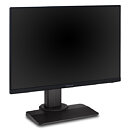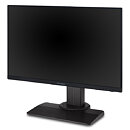- Joined
- Oct 9, 2007
- Messages
- 47,670 (7.43/day)
- Location
- Dublin, Ireland
| System Name | RBMK-1000 |
|---|---|
| Processor | AMD Ryzen 7 5700G |
| Motherboard | Gigabyte B550 AORUS Elite V2 |
| Cooling | DeepCool Gammax L240 V2 |
| Memory | 2x 16GB DDR4-3200 |
| Video Card(s) | Galax RTX 4070 Ti EX |
| Storage | Samsung 990 1TB |
| Display(s) | BenQ 1440p 60 Hz 27-inch |
| Case | Corsair Carbide 100R |
| Audio Device(s) | ASUS SupremeFX S1220A |
| Power Supply | Cooler Master MWE Gold 650W |
| Mouse | ASUS ROG Strix Impact |
| Keyboard | Gamdias Hermes E2 |
| Software | Windows 11 Pro |
ViewSonic Corp., a leading global provider of display solutions, announces that the latest gaming monitor, the XG2431, has started shipping. The ultra-sleek 24" display is equipped with an IPS panel that deliver vibrant visuals with an ultra-fast 1 ms response. Approved by industry-renowned Blur Busters* for its motion blur reduction, it gives players the power to compete alongside the pros in the highest levels of First-Person Shooter (FPS), Multiplayer Online Battle Arena (MOBA), and Real-Time Strategy (RTS) genres.
With native Full HD 1080p resolution and 240 Hz refresh rate, professional gamers can gain an edge. The sleek borderless design and wide viewing angles ensure that the XG2431 is ideal for multi-display gaming setups with minimal frame distraction, making it perfect for gaming arenas and tournament play. The ViewSonic XG2431 features AMD FreeSync Premium technology, which synchronizes the output of the GPU graphics card and monitor to eliminate screen tearing and provide smoother frame rates. This 24-inch monitor features the perfect combination of speed, control and color. The super smooth 240 Hz refresh rate allows games to run at an ultra-fast framerate for superior performance, while the 1 ms response time ensures faster and more precise gameplay.



"The XG2431 gaming monitor is the latest monitor engineered specifically for the hard-core gamer," said Ray Hedrick, product manager at ViewSonic. "We loaded the monitor with features and technologies that can keep up with high-end graphics cards and CPUs and make the players ready for any type of game, whether at home streaming or during a competition."
The XG2431 comes with the company's exclusive ViewMode presets, which offer the user a number of customizable gaming modes, including FPS, RTS and MOBA game settings. Connectivity options include HDMI, USB, and DisplayPort for external devices and accessories, and support for laptops, PCs and Macs.
XG2431 Gaming Monitor
View at TechPowerUp Main Site
With native Full HD 1080p resolution and 240 Hz refresh rate, professional gamers can gain an edge. The sleek borderless design and wide viewing angles ensure that the XG2431 is ideal for multi-display gaming setups with minimal frame distraction, making it perfect for gaming arenas and tournament play. The ViewSonic XG2431 features AMD FreeSync Premium technology, which synchronizes the output of the GPU graphics card and monitor to eliminate screen tearing and provide smoother frame rates. This 24-inch monitor features the perfect combination of speed, control and color. The super smooth 240 Hz refresh rate allows games to run at an ultra-fast framerate for superior performance, while the 1 ms response time ensures faster and more precise gameplay.



"The XG2431 gaming monitor is the latest monitor engineered specifically for the hard-core gamer," said Ray Hedrick, product manager at ViewSonic. "We loaded the monitor with features and technologies that can keep up with high-end graphics cards and CPUs and make the players ready for any type of game, whether at home streaming or during a competition."
The XG2431 comes with the company's exclusive ViewMode presets, which offer the user a number of customizable gaming modes, including FPS, RTS and MOBA game settings. Connectivity options include HDMI, USB, and DisplayPort for external devices and accessories, and support for laptops, PCs and Macs.
XG2431 Gaming Monitor
- 24-inch gaming monitor with native 1080p (1920x1080) resolution
- 240 Hz refresh rate; ultra-fast 1 ms (MPRT) response time
- AMD FreeSync Premium technology; Blur Busters approved; Exclusive PureXP technology
- VESA HDR400 Certified
- Connectivity includes: HDMI 1.4, DisplayPort, USB-A/B and Audio-Out
- Available now for an estimated street price of $349.99
View at TechPowerUp Main Site






 don't jinx it though...or just blame New World for it.
don't jinx it though...or just blame New World for it.
